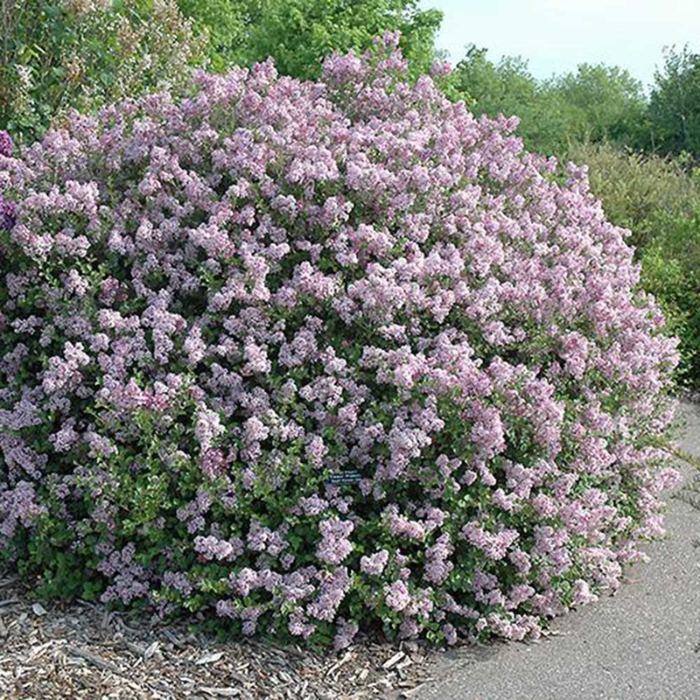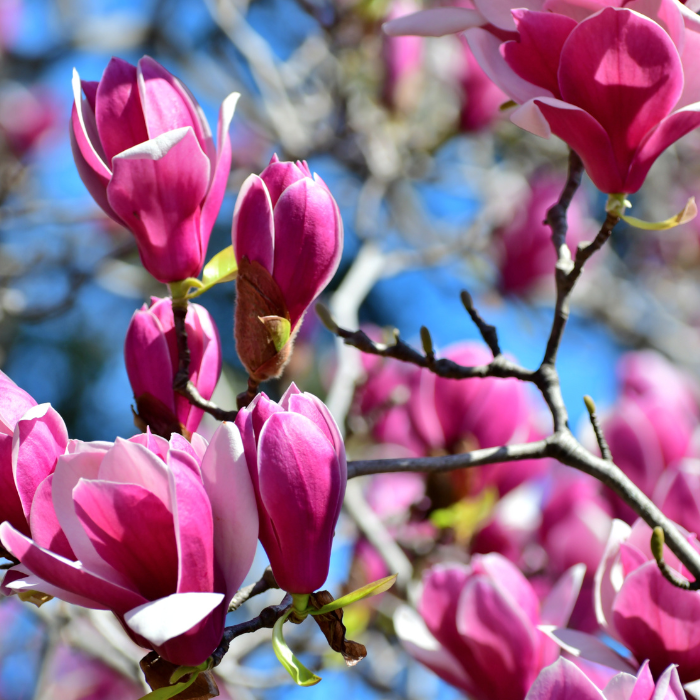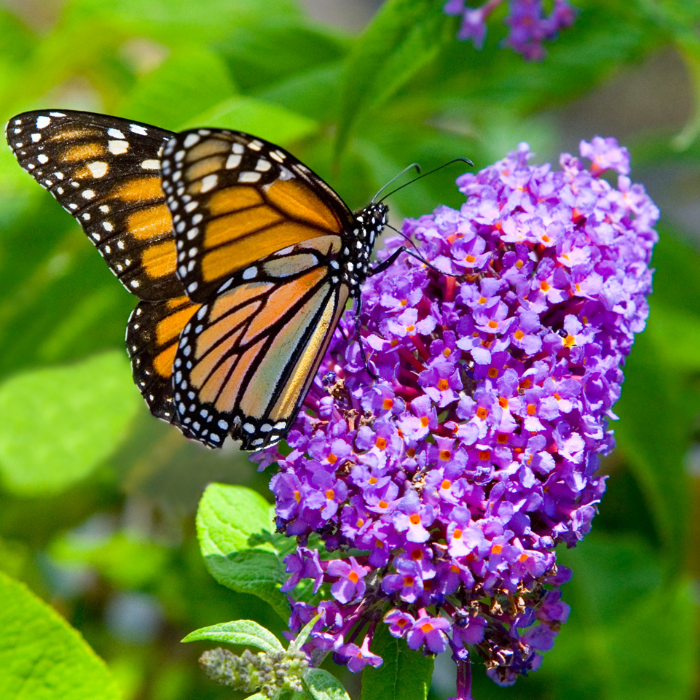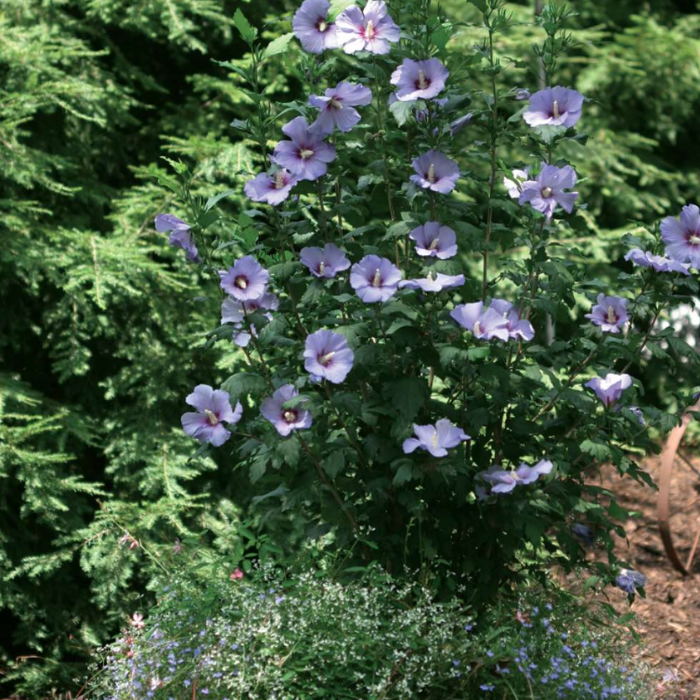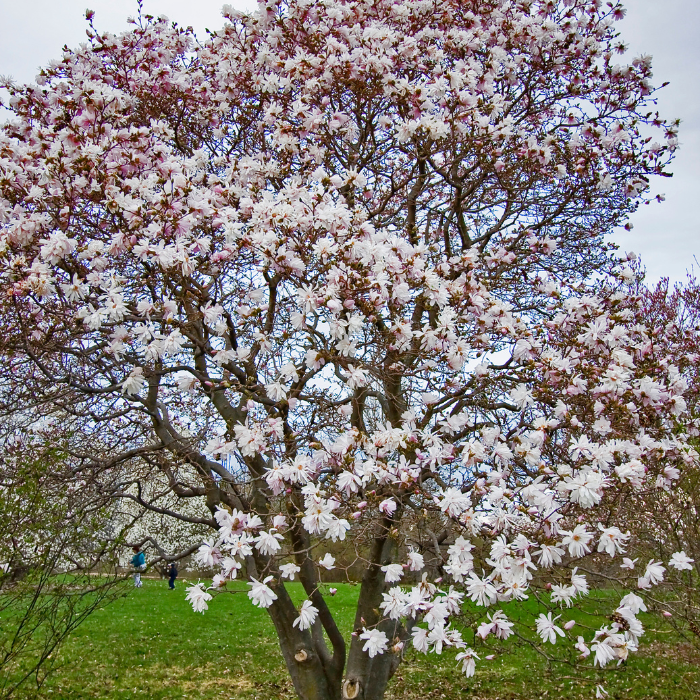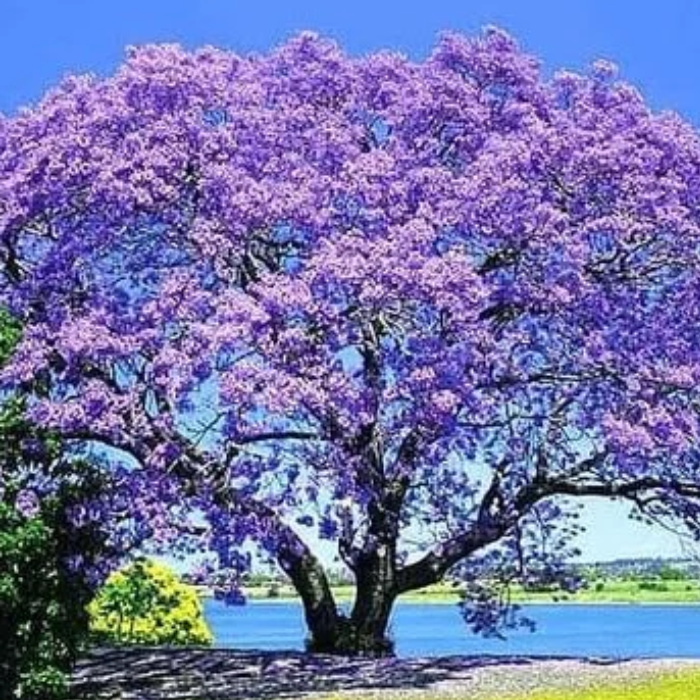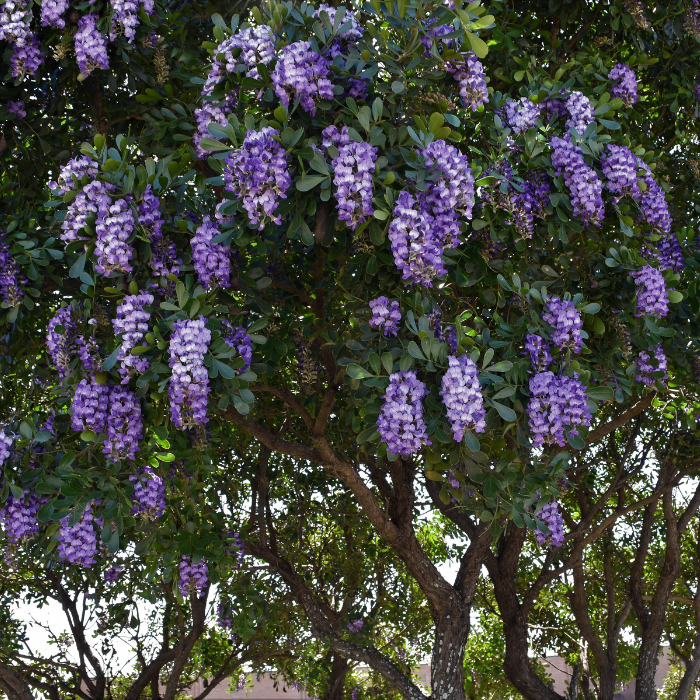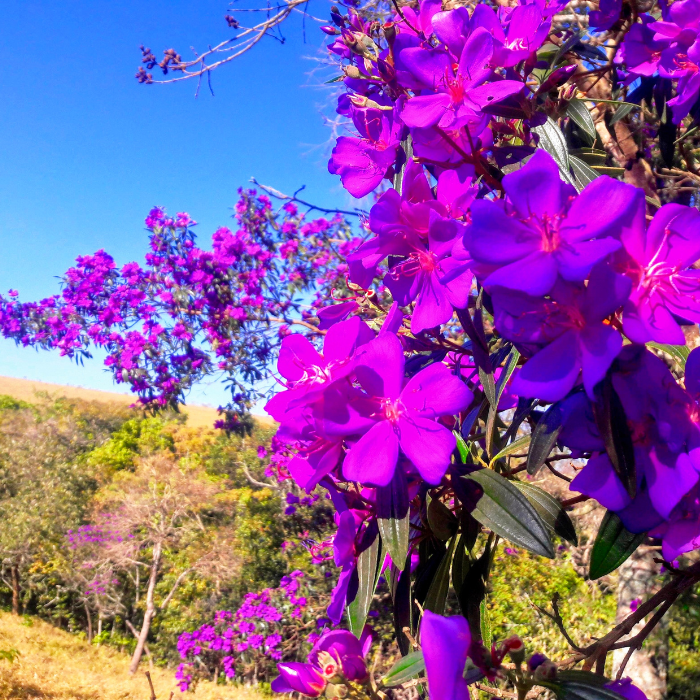
Fed up of your garden looking a little plain? Sometimes, our gardens need an injection of colour to really bring them to life. And what better way to do this than with a blue flowering tree?
Trees that produce blue flowers come in an array of shapes and sizes and have varied maintenance requirements. But they all have one thing in common – their captivating blue flowers.
In this blog post, we’ll talk you through 15 fantastic blue flowering trees. Some may be flashy, while others will add just a hint of vibrancy and elegance to your garden. So, let’s explore these gems together to find the perfect one for your outdoor space.
Small or Dwarf Blue Flowering Trees
1. Chinese Blue Wisteria (Wisteria sinensis ‘Prolific’)
We love a Wisteria tree in the UK. You’ll see them decorating the front facade of homes all across the country, showing off their glorious violet-blue blooms, typically between April and June.
Chinese Blue Wisteria is, as you can imagine, a Chinese native tree. It’s a cultivar of the Chinese Wisteria, which secures the prize for the most popular Wisteria variety in the UK.
This tree sports a winning combination of cascading pea-shaped blooms and a heady fragrance, which unsurprisingly attract a whole range of pollinators.
READ NEXT: Wisteria Care Guide: How to Grow These Beautiful Climbers
2. Blue Hong Kong Orchid Tree (Bauhinia grandidieri ‘Blue Hong Kong)
The Blue Hong Kong Orchid Tree has high prestige in the flowering tree world, being considered one of the most beautiful of its kind, not only in its native region but the world! It produces orchid-like blooms that sport an unusual pale lilac-blue colour, giving this variety an edge over some of the more common types of Orchid Trees.
This small evergreen grows to between 3 and 6 metres, growing up to around 60 cm per year, so it’s perfect for a small or medium-sized garden.
3. Tree Lilac (Syringa vulgaris)
If there’s one thing we love about the Tree Lilac, it’s its aroma. In spring, this small tree or deciduous shrub sports flamboyant lilac flowers that emit a powerful scent which pollinators can’t get enough of.
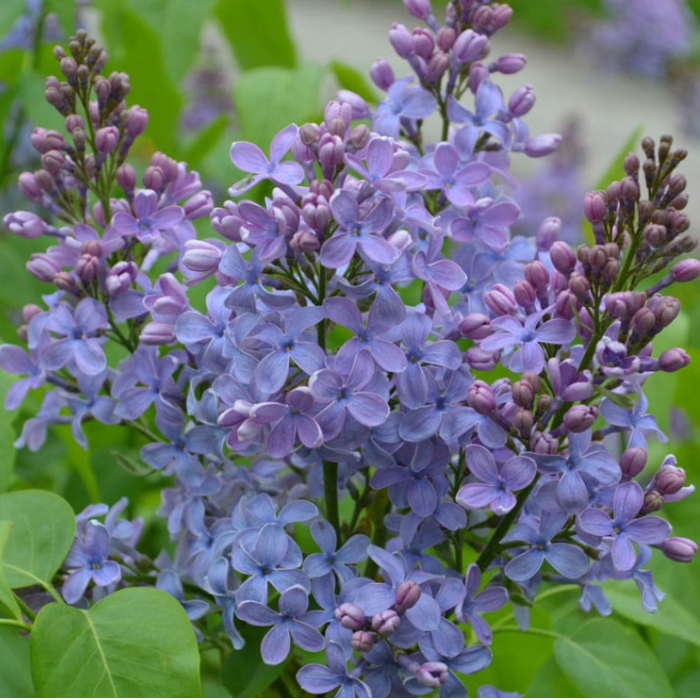
It’s native to southeastern Europe, so it can tackle our UK climate with no fuss whatsoever – even our harshest frosts! This makes it a relatively low-maintenance addition to a garden, perfect for you if you have little time to spare for gardening day to day.
4. Korean Lilac (Syringa meyeri ‘Palibin’)
Another popular Lilac with distinctive blue flowers is the Korean Lilac. The Korean Lilac is a glorious dwarf Lilac to have in your garden. Its 1.5-metre height and 2-metre spread make it ideal for a tight corner or small garden. It has light-coloured, lilac-pink flowers with a slight blue tinge and, like the Tree Lilac, gives off a punchy scent that attracts pollinators – including butterflies and hummingbirds – in droves.
This tree’s endemic region (northern China) isn’t quite so close to home, yet due to its hardiness to cold temperatures makes it well-suited to UK gardens.
5. Black Lily Magnolia (Magnolia liliiflora)
Captivating, deep purple blooms, reminiscent of dark sapphires, adorn the Black Lily Magnolia’s branches in spring, making it a powerful choice of tree for a UK garden. It typically grows as a shrub or small tree, never exceeding 4.5 metres tall, so its compact size makes it suitable for smaller gardens or as a decorative focal point in larger landscapes.
This Magnolia is hardy in the UK climate and can withstand colder temperatures, so it’s well-suited to gardens across the country and won’t require much maintenance. Just prune it once a year to maintain its shape and remove dead or damaged branches, and it’ll perform well year after year.
6. True Blue Butterfly Bush Tree (Buddleia ‘Bostulu’)
True Blue Butterfly Bush Tree has lavender blue flower panicles that provide a stark contrast from their unusual silvery-green leaves. Called the Butterfly Bush for a reason, this tree attracts butterflies and bees in abundance, making it a great choice for a wildlife or country garden.
While Buddleias are usually shrubs, this particular variety takes the form of a small tree, making it perfect for adding height to a border or container in a small garden.
READ NEXT: Buddleia Care Guide: How to Grow Butterfly Bush
7. ‘Blue Satin’ Rose of Sharon (Hibiscus Syriacus ‘Blue Satin’)
‘Blue Satin’ Rose of Sharon is actually a shrub, but anyone can easily train it into a tree by choosing a stem that will be the trunk and pruning the lower stems so it grows in a tree shape rather than a shrub form.
The ‘Blue Satin’ Rose of Sharon typically grows between 240 cm – 3 metres tall and produces a glorious display of lavender-blue blooms decorated with dark purple central veins, so it’ll surely pack a punch in a small or medium-sized space.
Tall Blue Flowering Trees
8. Ironwood (Memecylon Umbellatum)
The Ironwood tree is beautiful and useful in equal measure. In its native region – eastern Asia to India and Sri Lanka – its timber is used for building boats and houses, and a yellow dye is extracted from its bark. It produces vibrant blue flowers twice a year in tiny clusters, making it an interesting attraction in the dry, lowland forests and coastal areas it typically resides in.
9. Blue Magnolia (Magnolia sprengeri ‘Diva’)
Blue Magnolia is a captivating addition to any garden, renowned for its striking azure-hued blossoms. This deciduous tree, originating from Asia, boasts large, goblet-shaped flowers that appear in early spring. ‘Diva’ stands out as a stunning, rare gem among the world of blue-flowering trees, making it an excellent choice for a UK garden.
10. Princess Tree (Paulownia Tomentosa)
The Princess Tree, also commonly known as the “Empress Tree,” has been named the fastest-growing tree in the world and grows over 30 metres tall across its lifespan. However, its speedy growth isn’t the only quality the Princess Tree is known and loved for – it also produces captivating, trumpet-shaped flowers that sport a similar shape to Foxglove flowers. They appear in abundance in April and May and boast a calming, pastel lilac-blue colour.
Evergreen Blue Flowering Trees
11. Texas Mountain Laurel (Sophora secundiflora)
When it comes to the Texas Mountain Laurel, there’s a lot to like. It shows off a wonderful combination of wisteria-like flowers in spring, followed by furry seed pods and evergreen foliage. These qualities ensure year-round interest, making it one of the best on this list if you’re looking for a plant that won’t just look good for summer.
The Texas Mountain Laurel is actually a shrub, but it can be trained as a tree, either with a single trunk or multiple thin trunks. It’s one of the hardiest trees on this list, as it can thrive in nutrient-poor soils and the harshest of droughts. Due to this, it makes an excellent tree for xeriscaping.
12. Purple Glory Tree (Tibouchina granulosa)
The Purple Glory Tree is a small evergreen tree or shrub that deserves all the glory when it’s in full bloom. This tropical tree endemic to Brazil blooms in an array of colours, from violet-blue to a deep, rosy red. While it may not flower intermittently as it does in the tropics, it should bloom at least once per year – you can optimise its floral display by pinching out new growth.
If you want to grow the Purple Glory Tree, give it a sunny spot that receives at least 6 hours of sunlight every day, and plant it in well-drained, moist soil. While it loves afternoon shade in the tropics, it’ll take all the sun it can get here in the UK.
13. Jacaranda caerulea ‘Boxwood’
Jacaranda caerulea ‘Boxwood’ is a flowering tree that produces trumpet-shaped pale purplish-blue flowers intermittently in spring and summer, so you get quite the display with this one!
To some, Jacaranda caerulea ‘Boxwood’ is known as the “Cancertree” due to its uses in alternative medicine to treat various skin complaints, such as skin cancer. While this tree is originally from Cuba, the Bahamas, and Hispaniola, it’s now a popular ornamental plant in Florida, and you may even find it in gardens in the UK, although not often!
Jacaranda caerulea ‘Boxwood’ is an evergreen, keeping its leaves throughout the whole year, and grows to around 14 metres over its lifetime if given optimal growing conditions.
Tropical Blue Flowering Trees
14. Blue Jacaranda (Jacaranda mimosifolia)
When people think of a blue flowering tree, it’s usually the Blue Jacaranda. This is the most common blue flowering tree, known and adored for its long-lasting triangular-shaped clusters of violet-blue flowers.
If you have spotted this tree, you’ll likely have seen it on holiday somewhere exotic, in a tropical or subtropical region of the world, as this is where it naturally resides. It is possible to grow this tree in the UK, provided you give it winter protection in a conservatory or greenhouse. But if you want your Blue Jacaranda to flower, you might be disappointed, as this tree rarely flowers in the UK due to the colder climate.
15. Blue Crepe Myrtle (Lagerstroemia)
While most Crepe Myrtle trees produce vibrant pink flowers, you can get varieties that produce blue-purple flowers. The Blue Crepe Myrtle is a highly unique Myrtle variety with pale, white bark and distinguishing blue flowers. Unfortunately, these aren’t as readily available, so you may need to search far and wide!
If you manage to lock down a Blue Crepe Myrtle, there’s good news – these varieties happily grow in more sheltered spots in the UK, such as in front of a fence or wall, protected from heavy rain and strong winds.
Final Word on Blue Flowering Trees
Blue flowering trees offer a range of benefits for our gardens. Not only are they vibrant and so naturally draw the eye, but they can also introduce numerous pollinating species, increasing the biodiversity in your garden and ensuring you do your bit for the local wildlife.
Whether you want a dwarf tree to suit your small garden or a tree that towers over everything, an exotic one or one that lives a little closer to home, there’s a blue flowering tree to suit your space.
Blue Flowering Trees FAQs
Is there a tree that has blue flowers?
The Blue Jacaranda is the most common tree that produces blue flowers. This tree is a South American native and produces a collection of funnel-shaped flowers that appear in late spring and continue into early summer.
What tree has blue flowers in the UK?
California Lilac, also commonly known as “Ceanothus,” is a big, bushy shrub that is often mistaken for a tree. It’s a favourite in the UK due to its captivating clusters of blue blooms that turn the shrub into a blue mound, typically in early summer.
What kind of tree has blue bell-shaped flowers?
The Vietnamese Blue Bell is a popular ornamental tree that’s mostly cultivated for use as a bonsai. However, it grows naturally in savannas and forests across Asia. It has unique, bell-shaped blooms in a striking lilac-purple shade.
Are there any evergreen blue flowering trees?
Most blue flowering trees are deciduous. However, the Texas Mountain Laurel (Sophora secundiflora), Purple Glory Tree (Tibouchina granulosa) and Jacaranda caerulea ‘Boxwood’ are three popular evergreen blue flowering trees used for ornamental purposes.
If you love our collection of blue flowering trees and want to add some sunny colour to your garden, too, check out our list of 21 Yellow Flowering Shrubs!


